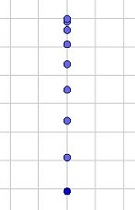
login - create an account - help

Free Fall Model
written by
Andrew Duffy
The Free Fall model allows the user to examine the motion of an object in freefall. This is simply one-dimensional motion (vertical motion) under the influence of gravity.
The Free Fall model was created using the Easy Java Simulations (EJS) modeling tool. It is distributed as a ready-to-run (compiled) Java archive. Double clicking the ejs_bu_freefall.jar file will run the program if Java is installed. Please note that this resource requires at least version 1.5 of Java (JRE).  1 source code document is available
1 source code document is available
The source code zip archive contains an XML representation of the Free Fall model. Unzip this archive in your EJS workspace to compile and run this model using EJS. download 5kb .zip Published: April 25, 2010 previous versions
Next Generation Science StandardsCrosscutting Concepts (K-12)
Patterns (K-12)
NGSS Science and Engineering Practices (K-12)
Analyzing and Interpreting Data (K-12)
Developing and Using Models (K-12)
Using Mathematics and Computational Thinking (5-12)
NGSS Nature of Science Standards (K-12)
Analyzing and Interpreting Data (K-12)
Developing and Using Models (K-12)
Using Mathematics and Computational Thinking (5-12)
AAAS Benchmark Alignments (2008 Version)4. The Physical Setting
4B. The Earth
4G. Forces of Nature
11. Common Themes
11B. Models
Common Core State Standards for Mathematics AlignmentsStandards for Mathematical Practice (K-12)
MP.4 Model with mathematics.
High School — Algebra (9-12)
Creating Equations? (9-12)
Reasoning with Equations and Inequalities (9-12)
High School — Functions (9-12)
Linear, Quadratic, and Exponential Models? (9-12)
ComPADRE is beta testing Citation Styles!
<a href="https://www.compadre.org/portal/items/detail.cfm?ID=10001">Duffy, Andrew. "Free Fall Model."</a>
A. Duffy, Computer Program FREE FALL MODEL (2010), WWW Document, (https://www.compadre.org/Repository/document/ServeFile.cfm?ID=10001&DocID=1639).
A. Duffy, Computer Program FREE FALL MODEL (2010), <https://www.compadre.org/Repository/document/ServeFile.cfm?ID=10001&DocID=1639>.
Duffy, A. (2010). Free Fall Model [Computer software]. Retrieved April 25, 2024, from https://www.compadre.org/Repository/document/ServeFile.cfm?ID=10001&DocID=1639
Duffy, Andrew. "Free Fall Model." https://www.compadre.org/Repository/document/ServeFile.cfm?ID=10001&DocID=1639 (accessed 25 April 2024).
Duffy, Andrew. Free Fall Model. Computer software. 2010. Java (JRE) 1.5. 25 Apr. 2024 <https://www.compadre.org/Repository/document/ServeFile.cfm?ID=10001&DocID=1639>.
@misc{
Author = "Andrew Duffy",
Title = {Free Fall Model},
Month = {April},
Year = {2010}
}
%A Andrew Duffy %T Free Fall Model %D April 16, 2010 %U https://www.compadre.org/Repository/document/ServeFile.cfm?ID=10001&DocID=1639 %O application/java %0 Computer Program %A Duffy, Andrew %D April 16, 2010 %T Free Fall Model %8 April 16, 2010 %U https://www.compadre.org/Repository/document/ServeFile.cfm?ID=10001&DocID=1639 Disclaimer: ComPADRE offers citation styles as a guide only. We cannot offer interpretations about citations as this is an automated procedure. Please refer to the style manuals in the Citation Source Information area for clarifications.
Citation Source Information
The AIP Style presented is based on information from the AIP Style Manual. The APA Style presented is based on information from APA Style.org: Electronic References. The Chicago Style presented is based on information from Examples of Chicago-Style Documentation. The MLA Style presented is based on information from the MLA FAQ. This resource is stored in 19 shared folders. You must login to access shared folders. Free Fall Model:
Is Based On
Easy Java Simulations Modeling and Authoring Tool
The Easy Java Simulations Modeling and Authoring Tool is needed to explore the computational model used in the Free Fall Model. relation by Mario Belloni
Is a Teaching Guide For
Physics Classroom: Introduction to Free Fall
Is a Teaching Guide For
Physics Classroom: The Acceleration of Gravity
Is a Teaching Guide For
Physics Classroom: Representing Free Fall by Graphs
Is a Teaching Guide For
Physics Classroom: How Fast? and How Far?
Know of another related resource? Login to relate this resource to it. |
SupplementsContributeRelated Materials
Is Based On
Easy Java Simulations Modeling and Authoring Tool Is a Teaching Guide ForPhysics Classroom: Introduction to Free Fall Is a Teaching Guide ForSimilar Materials |